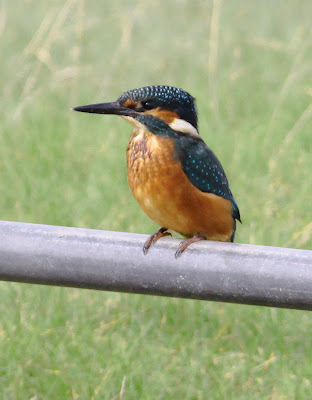A wind free morning should have brought about a ringing session but a sleepless night followed by lethargy and a lack of motivation meant a few hours after-lunch birding at the usual spot would have to suffice.
With a high tide due at 1345 I made my way up to Pilling Water, stopping briefly in the car park to watch a Chiffchaff flitting through the trees with a party of Long-tailed Tits. As I left the wood behind there was a single fence-hopping Wheatear and then a Skylark flying across my path and into the field. Skylarks have been very scarce along here since the end of the breeding season, and although it is a species adept at being inconspicuous there just aren’t any around until we receive an influx of migrant and wintering birds.
Long-tailed Tit
Skylark
It was a quiet sort of day for counting with a tide that although full, did not reach sufficient heights to fetch birds in, so just 18 Pintail, 25 Shelduck, 9 Cormorant, 140 Wigeon, 75 Teal, 3 Snipe, 300 Curlew, 8 Little Egret, 2 Grey Heron and 1 Raven.
This is getting to be something of a habit, but there was a Marsh Harrier again today, this one confounding my previous theory of different individuals by appearing from near Fluke Hall then flying rapidly north-east, and last seen high over Cockerham Marsh. Below is a very distant shot of the characteristic “V” shaped flight pattern with Heysham Power Station getting in on the act.
Marsh Harrier and Heysham
Sometimes, and on a sunny day the incoming tide can make a decent photograph. Don’t worry about the sheep, they can swim and are able to judge the rising tide to perfection, knowing exactly when to seek the safety of higher ground. Heysham Power Station vies for attention again.
High Tide at Pilling and distant Heysham
From the stile I watched as hordes of Swallows hawked insects over Broadfleet and Pilling village. I think there had been a hatch of flying ants, an event which probably accounted for the sudden concentration of birds and my count of 300+ Swallows and 20+ House Martins.
While scrutinizing the Swallows I spotted a Kingfisher sat quietly in a streamside bush. Within seconds the Kingfisher flew across to the outflow fence from where it proceeded to fish in the tidal water. Not daring to move I snapped a number of shots as the Kingfisher dived a number of times before emerging with tiny fish. Each time the Kingfisher would batter the tiny fish against the concrete apron, before twisting them around so as to allow the bird to swallow the fish head first. What appears to be to be some sort of line or string is vegetable matter that the Kingfisher pulled out with the fish.
Sight of a shy Kingfisher makes for a special birding day, more so to watch one fishing rather than the more familiar frustration of a flash of blue disappearing into the watery distance. For the benefit of blog readers from North America who are more accustomed to seeing Belted Kingfishers, our European Kingfisher at about 6 inches, is half the size of the Belted Kingfisher.
Kingfisher
Kingfisher
Kingfisher
Kingfisher
Kingfisher
Kingfisher
Kingfisher
Kingfisher
For Kingfisher fans, there are lots of better pictures at an earlier Another Bird Blog post, here.
Today’s post links up with Stewart’s World Bird Wednesday at
http://paying-ready-attention-gallery.blogspot.com.au/
More news fron Another Bird Blog pretty soon, stay tuned.









































































.jpg)












